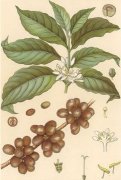Processing methods of coffee beans and raw coffee beans
Raw beans are generally washed and dried, both of which can produce high quality raw beans.

Washing method: Generally speaking, there will be a relatively bright acidity and a more consistent flavor. During the washing method, the pulp is immediately separated from the raw beans, rather than drying them like drying method. The procedure is as follows:
1. Selection: Put the fruit into a tank and let stand for about 24 hours. Ripe and immature are classified by sinking and rising, respectively, due to differences in density.
2. Pulp removal: The coffee fruit enters the pulp removal machine through the water flow, the coffee beans and pulp are separated and spit out from two different outlets, and the pulp and skin floating on the water surface are carried away by the water flow.
3. Fermentation: Coffee beans stored in fermentation tank for about a day, so that the remaining pulp fermentation peeling, by the way will also dissolve the coffee bean surface of the sticky matter.
4. Water washing: wash thoroughly in the washing field.
5. Drying: dry for several days, even if it rains, you can delay drying for a few days.
II. Drying method: drying method processing coffee acidity is lower, flavor also has more changes.
1. Separation: Separate ripe beans from immature beans in a manner similar to washing.
2 drying: spread in the drying field for sun drying. It usually takes 1 to 2 weeks, and due to the long time, special attention must be paid to climate change. In addition, coffee beans must be raked regularly every day to prevent fermentation and to dry coffee beans evenly. The moisture content of dried young beans dropped to about 12%.
3. Shelling: The dried coffee beans are sent to a hulling machine for hulling.
Except for parts of Brazil and Ethiopia, most Arabica species are treated by washing, while Robb's special species are treated by washing only in parts of Indonesia, and almost all others are treated by drying.
Important Notice :
前街咖啡 FrontStreet Coffee has moved to new addredd:
FrontStreet Coffee Address: 315,Donghua East Road,GuangZhou
Tel:020 38364473
- Prev

Coffee species Coffee trees can be roughly divided into five types
Coffee is called coffea in the biological genus. This genus is a member of the Rubiaceae family. It has more than 500 species and more than 6000 varieties, most of which are tropical trees and shrubs. From the point of view of drinkers, coffee trees can be roughly divided into five species, of which Arabica and Robusta are more common. Arabica species account for more than 70% of the world's total output.
- Next

Basic principles of roasting coffee beans
The raw coffee beans are fried to make the coffee beans show a unique coffee color, aroma and taste. The most important thing of frying and baking is to be able to stir-fry the inside and outside of the beans evenly without overscorching. 80% of the taste of coffee depends on roasting, which is the most important and basic condition for making good coffee. The most important thing is to be able to stir-fry the inside and outside of the beans evenly. First of all, through firepower.
Related
- Beginners will see the "Coffee pull flower" guide!
- What is the difference between ice blog purified milk and ordinary milk coffee?
- Why is the Philippines the largest producer of crops in Liberia?
- For coffee extraction, should the fine powder be retained?
- How does extracted espresso fill pressed powder? How much strength does it take to press the powder?
- How to make jasmine cold extract coffee? Is the jasmine + latte good?
- Will this little toy really make the coffee taste better? How does Lily Drip affect coffee extraction?
- Will the action of slapping the filter cup also affect coffee extraction?
- What's the difference between powder-to-water ratio and powder-to-liquid ratio?
- What is the Ethiopian local species? What does it have to do with Heirloom native species?

